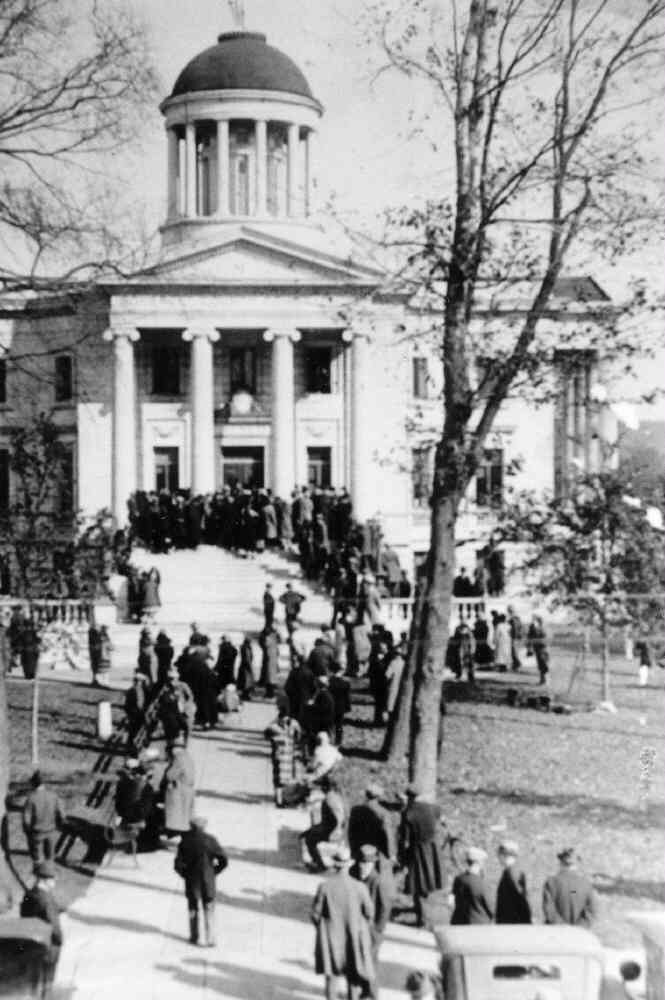By Bruce Doorly

Well, I did get put on a criminal case, but to my surprise I quickly realized that the historic courthouse is called “historic” for a reason. For the most part it is no longer used for criminal trials. Only some civil trials are held there. That other five story modern building on the same property behind the church has been the main courthouse since 1986 – for thirty-eight years now.
Obviously, my knowledge about the Somerset County Courthouse needs updating. So, I will make it the topic of my research and my article for this month.

The next year a new second courthouse was built in Millstone near where the Hillsborough Reformed Church is today. This courthouse was intentionally burnt down by the British during the Revolutionary War in 1779 in an offensive that came to be known as Simcoe’s Raid.
In 1782, towards the end of the Revolutionary War a third courthouse was built, this time in Somerville. This courthouse was said to be small and was located where the Somerset Administration Building is today. Building the courthouse in Somerville played a major factor in the growth of the town. As people tended to live around where the legal records are kept and the trials are held.
Burnt The Somerset County Courthouse

After serving the county for over 100 years, in 1905, the county freeholders had decided that the old courthouse building no longer met their needs and should be torn down for a modern one. Many residents thought that the old building was a significant landmark and should be preserved. Their reasoning included that there was plenty of room on the property to build a new courthouse and that the old courthouse could be used for offices. But this reasoning did not prevail in 1905.
Ironically, decades later that reasoning did prevail when in the 1980-90s it became time to transition from courthouse #5 to #6. But in 1905, the old courthouse was sold to a junk dealer for $125 before being torn down.
1799-1905
The architect J. Riely Gordon was an excellent choice. He previously had designed the Capitol Building of Arizona and 70 other courthouses. He designed it of “Alabama Marble”. Inside he designed a beautifully paneled rotunda extending from the ground floor to a glass dome in the roof.
There were five courtrooms opening into the galleries on different floors around the central rotunda. It was three stories high, containing forty-six offices and rooms.

With central air-conditioning still a half century away, he developed a unique ventilation system to cool the building - drawing the cool air from the basement area.
At the top of the courthouse dome is the “Statue of Justice”. A woman in a classical Roman robe wielding a sword and a balance to signify that justice is fair and balanced. She is also wearing a blindfold as a further symbol that justice is blind and applies to all.
Teddy Roosevelt in his bid to return to the Presidency spoke on the courthouse steps in 1912.
Click for photo from today

On March 2nd 2006 Charles Cullen, a nurse who administered lethal injections to dozens of patients, was sentenced at the courthouse to life in prison. The courtroom was one of the few big enough for the 150 people that included both reporters and families of victims.
Click for story

The new sixth courthouse was finished in 1986. This courthouse, as we see today, is a five-story rectangle office building. It has seven courtrooms, many offices, and a lookout section on the top floor that provides an excellent view of Somerville.
However, it has none of the prominent architecture that the previous two courthouses had.

From 1992-1996 the building underwent a seven-million-dollar renovation. It was brought up to “code” by adding an elevator, sprinkler system, fire doors, and brass safety railings.

The marble exterior was power washed, the front steps were removed and reassembled for better support, two-lamp posts in front that had been in storage for years were remounted, the courtroom seats were restored as were the oak doors.
The statue of justice on top of the building was given a new gold covering.
When the restoration was completed, in June of 1996, a rededication ceremony was attended by 400 people with Governor Christie Whitman serving as the keynote speaker.

Perhaps the most important use today for the historic courthouse is the holding of patriotic functions, speeches, and concerts on the property that is formally recognized as “On the Green.” The courthouse steps serve as a stage for countless events with the marble columns with its beautiful design in the background.

His sister who had passed away in 1908 requested that the monument be a drinking fountain for "man and beast" in memory of her brother. She left $16,000 in her will for the building of the fountain.

A large basin with bronze chains was placed in the front for horses, while the backside of the fountain had a water fountain for people.
In the year 2000 it was restored. The chain links were replaced by newer ones identical to the originals, the marble surface was refinished, and the lion's head was repaired.
It is listed on the National Register of Historic Places.
The congregation dates back to 1699. Another church building was in that location before the stone church was built.

At the urging of local residents and historical groups it was preserved.
It has been renovated and used for the jury gathering area since 1986.